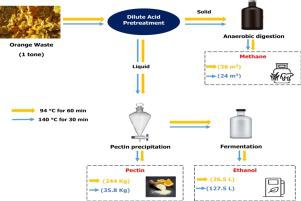Process Safety and Environmental Protection ( IF 6.9 ) Pub Date : 2021-06-09 , DOI: 10.1016/j.psep.2021.06.013 Safoura Vaez , Keikhosro Karimi , Safoora Mirmohamadsadeghi , Azam Jeihanipour

|
Orange wastes, including peel and pulp, were used as a biorefinery feedstock to produce pectin, ethanol, and biogas. The orange wastes were subjected to dilute acid treatment with sulfuric acid (1% w/v) at 94, 100, 140, and 180 °C for 60, 30, and 0 min. The sulfuric acid treatment was performed for pectin extraction, sugars hydrolysis, and lignocellulose pretreatment. The pectin was extracted from the hydrolysate, the liquor was used to produce ethanol, and the pretreated solid was anaerobically digested to produce biogas. The highest pectin extraction yield was 24.7 % (w/w) from orange peel and 23.7 % (w/w) from pulp, which was obtained from the supernatants of treatment at 94 °C for 60 min. Fourier transfer infrared spectrometer results confirmed the similar characteristics of the extracted pectin to a commercial product. The galacturonic acid content (an indicator of pectin purity) of pectin extracted from orange peel was 70.2 % and from orange pulp was 69.9 %, at the optimum conditions. The pectin obtained from the acid treatment at 94 °C for 60 min had a degree of esterification higher than 69 %, whereas it was less than 45 % for that obtained after treatment at 140 °C for 30 min. The maximum ethanol yields of 81.5 % (from peel) and 82.9 % (from pulp) were achieved from the hydrolysate of the acid treatment at 140 °C for 30 min. The highest methane yields were 176.8 mL/g volatile solids (from the untreated peel) and 191.8 mL/g volatile solids (from the untreated pulp). Overall, the maximum total product value was 2,472.9 USD/t orange wastes, which was achieved from dilute acid treatment at 94 °C for 60 min. At the optimal conditions for high production of pectin, without any enzyme consumption, 244 kg of pectin, 26.5 L of ethanol, and 36 m3 of methane were produced from 1 t of orange wastes.
中文翻译:

无需酶消耗,从橙子废物中生产果胶和生物燃料的最佳生物精炼开发
橙子废料,包括果皮和果肉,被用作生物精炼原料来生产果胶、乙醇和沼气。用硫酸 (1% w/v) 在 94、100、140 和 180 °C 下对橙色废物进行稀酸处理 60、30 和 0 分钟。硫酸处理用于果胶提取、糖水解和木质纤维素预处理。从水解液中提取果胶,用溶液生产乙醇,将预处理后的固体厌氧消化生产沼气。橙皮的最高果胶提取率为 24.7 % (w/w),果肉为 23.7 % (w/w),果胶是从 94 °C 处理 60 分钟的上清液中获得的。傅里叶转移红外光谱仪的结果证实了提取的果胶与商业产品的相似特性。在最佳条件下,从橙皮中提取的果胶的半乳糖醛酸含量(果胶纯度的指标)为 70.2%,从橙果肉中提取的果胶为 69.9%。在 94 °C 下酸处理 60 分钟获得的果胶的酯化度高于 69%,而在 140 °C 下酸处理 30 分钟后获得的果胶小于 45%。在 140 °C 下酸处理 30 分钟的水解产物实现了 81.5%(来自果皮)和 82.9%(来自果肉)的最大乙醇产率。最高的甲烷产量为 176.8 mL/g 挥发性固体(来自未处理的果皮)和 191.8 mL/g 挥发性固体(来自未处理的果肉)。总体而言,在 94 °C 下稀酸处理 60 分钟后,最高总产品价值为 2,472.9 美元/吨橙色废物。从 1 吨橙色废物产生3甲烷。











































 京公网安备 11010802027423号
京公网安备 11010802027423号